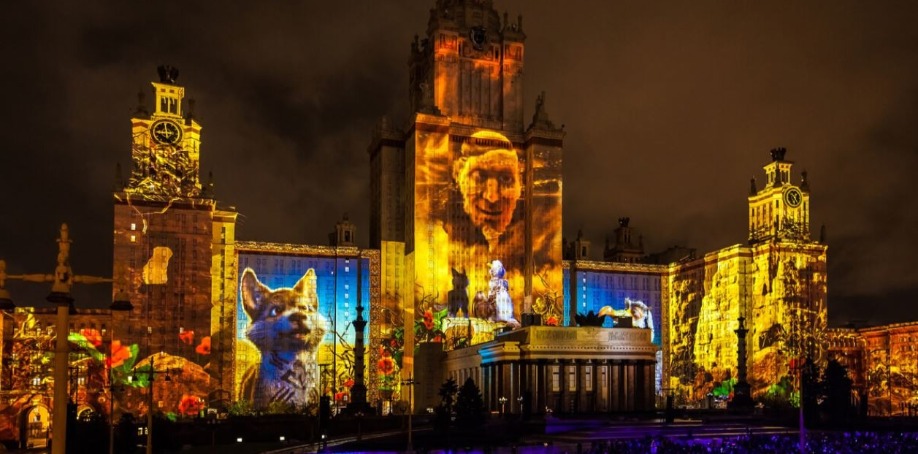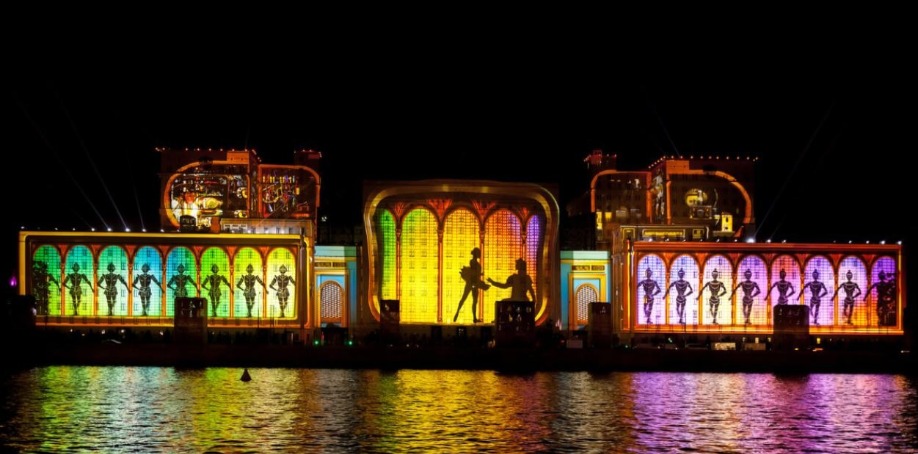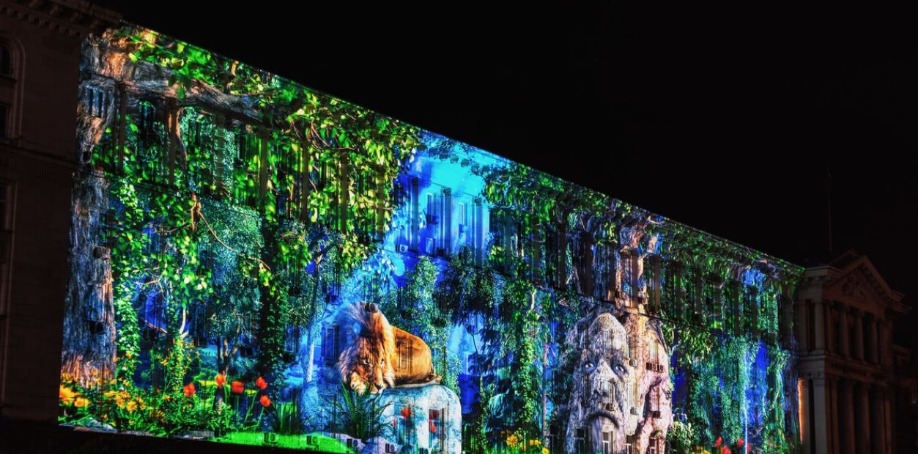
We live in a golden age of home entertainment. We can stream shows to our televisions, tablets and computers. And if we find a moment we love, we can replay it again and again. But something is missing at-home: totally immersive entertainment.
When we can see our dirty dishes and piles of laundry, can we really join the fantasy worlds appearing on our screens? Projection mapping could be the answer.
Customers are looking for the same thing, whether at a dance club, restaurant or holiday event: Immerse them in a spectacular or story, and they'll never forget that experience. They'll talk about it to friends and on social media, which word of mouth could help your company grow.
Below are some immersive entertainment examples plus few tips you can use in developing your next project.
Disney Shares a Happily Ever After
Ask your favorite 5-year-old princess if she wants to leave her costume behind and step into her own Disney movie, and she'll probably say "yes." Childhood superfans can grow up into adults that still dream of being part of the action. Disney's new show makes that dream a possibility.
The Happily Ever After show is projected onto the iconic Princess Castle during nightly fireworks displays. "With projection mapping technology, you can create an immersive environment for guests, taking them inside the films of Disney. It enables us to flood the palate and give our guests an opportunity to experience many of our characters' worlds in the same show," says James Silson, show director at The Walt Disney Company.
Rather than popping up disjointed images and flashing lights, the Disney team uses clips and songs from their iconic library. They highlight key moments and tug on heartstrings.
"The show will take guests on an emotional journey as favorite Disney characters set out to pursue their dreams, encounter obstacles (and villains!) to ultimately prevail and find their 'happily ever afters,'" said Jennifer-Fickley-Baker, editorial content manager for Disney Parks blog, when announcing the show in 2017.
This is a form of storytelling viewers find hard to forget. A quick search on YouTube pulls up dozens of videos of the show, and each video is filled with comments from customers that want to see it live. For some tourists, an immersive experience can mean the difference between booking the event and skipping it.
That user-created content is important, writes Lee Hayhurst, head of news at Travel Weekly Group. He points to a survey that found nearly half of millennials factor in social media when choosing holiday hot spots. If the location will look good in photos that they'll be sharing with friends, they're more likely to visit. If consumers use that same logic when choosing museums, dance clubs, restaurants and resorts, how will the average business stand up?
Companies that think about that wow factor could ensure future success.

Food Combines with Art
Eating delicious food is already an immersive experience. Diners might see, hear, smell, taste and feel each bite as it's prepared, delivered and consumed. But projection mapping is adding a storytelling element to further enhance dining.
One such experience opened to great fanfare in San Francisco. In the F.E.A.S.T. culinary popup, diners were treated to projection mapping that covered their tables, their plates, their hands, and more. Dishes seemed to swirl and glow, and consumers were encouraged to capture all the imagery with their phones. "With F.E.A.S.T., we have the opportunity to bring in the culinary arts as a layer to the immersive experience," said event producer Becca Dakini.
While the popup is no longer active, consumers hoping for a similar experience can check out an innovative, touring dining experience called the Dinner Time Story Show. Here, projection mapping is used to showcase a tiny chef that catches, cooks and seasons your food right on the table.
The show had a relatively soft launch. "We invited media, food bloggers and influencers to an opening show," says Nadine Beshir, producer of the Dinner Time Story show. Consumers filmed the action, and the word started to spread. Soon, reservations were filled, and the company encountered a different type of query.
"When we saw the amount of restaurants and hotels that started calling us after the first video, we realized that this concept could really bring visual mapping into the hospitality sector,” says Antoon Verbeeck, cofounder of Skullmapping, the company that developed the technology and illustrations used during the show.
Restaurant owners hoping to create a unique dining experience from that delivered around the corner or down the street could find similar success.
Dancers Feel the Beat
Lights have long been part of the club scene. They pulse along with the music, and they showcase musicians and DJs. But a club in North Carolina does a bit more.
Design company Xite Labs explains that the projection mapping installation in X Nightclub does more than illuminate the action. The design flows around the room's architecture, and makes the DJ look as though they are playing a gigantic and moving pipe organ. Club-goers tired of stereotypical light shows might be dazzled and amazed at a creative deployment like this. It could help keep dance clubs (and dance floors) full.
A different type of dance fan might also appreciate projection mapping. The San Francisco Ballet, for example, used projection mapping to kick off its 86th season. Patrons were treated to images of dangers spinning and leaping along the rotunda of the San Francisco City Hall.
"The projection was built to inspire, while incorporating elements of the San Francisco ballet, such as silhouettes of dancers, and slow-motion footage from the performances," says Sean Mason, founder and CEO of the production company Immersive.
This was an expensive event. Alix Martichoux of the San Francisco Chronicle says patrons paid at least $1,500 to attend the gala which included an after-party with the San Francisco Ballet. Adding projection mapping could be just what patrons needed to feel like part of the dance, rather than mere spectators.

Include Everyone in the Fun
Projection mapping installations are often large, and that makes them easy to see from far away. Size can work in your favor, as you work to immerse your audience and ensure that they have a good time.
Robert Niles, editor of Theme Park Insider, explains that Disney projection mapping projects can help to reduce tourist logjams. "When Disneyland programmed mapping into its Disneyland Forever fireworks show, it smartly designed projection effects throughout the park—on Main Street, on the castle, on the Matterhorn, and on the Small World facade—in order to draw fans away from its tiny (and still tree-filled) hub and distribute them throughout the park," he writes.
That step keeps people moving, so they won't clog up plazas and traffic zones. If flow is an issue for you, scattering multiple arrays around your space could be a smart tactic. You could even use the technology to encourage people to move.
"Brands have used it creatively to encourage and convince audiences to take a specific action. Consider, for example, how nightclubs use projection mapping to draw guests onto the dance floor. Art galleries have a similar technique that uses trails of light to guide audiences to view specific pieces of art," the team at Epson says.
And if you have a very large crowd, an installation that can be seen from almost everywhere can ensure that all of your guests have easy access to the fun.
That's what the Irish company UV Arts did for a Halloween festival expected to draw in 120,000 people. "We're taking the Derry Girls mural and dressing it up in true Halloween style. It will feature all things Halloween, and a few surprises, but we don't want to give too much away. It's mesmerizing what can be done with video mapping," says artist Donal O'Doherty of UV Arts.
A similar project in Germany used projection mapping to tell the story of a cathedral's past, and it was shown to approximately 40,000 spectators, says Michael Garwood at AV Technology.
A tiny piece of art would get crushed by so many visitors. But projection mapping allows you to share the work with a large group all at once.
Focus on the Story, Not the Technology
It's easy to get swept away by camera size, lumens and battery capacity. While it's critical to ensure that your project is technically viable, never forget that immersive experiences are emotional, not technical.
Beshir says the technology should be a tool that tells a story, not a gimmick. “It's like a play but with different media—and the food is part of the artistic expression," she says of her Dinner Time Story Show. For her, projection mapping helps to tell a story. Without it, her concept falls apart.
While you're proud of the hard work, programming and equipment that goes into an immersive experience like this, your visitors aren't.
“I never want people to see the technology. When you're watching a show, it's better to just let the magic happen,” says Steven Davison, vice president of parades and spectaculars at The Walt Disney Company.
Contractors can tuck cameras behind screens and plants, and do the work right before the show begins. Tacking cords down beneath ductwork can also help to hide the magic while reducing tripping hazards. The more contractors look for ways to hide the technology away, the more immersive the experience can become.
The technology itself has nearly unlimited uses. Eric Wade, production designer with the production solutions provider Crossfade Design, says projection mapping can make even boring, flat floors come alive with video and graphics. "There's really no limit to what you can do on these surfaces," he notes.
While you might be focused on using the technology in a big, splashy space (like on a stage), it's good to look for other ways to use it throughout the space to truly immerse your viewers in another world.
Images by: prescott09/©123RF.com, prescott09/©123RF.com,zheleva/©123RF.com


